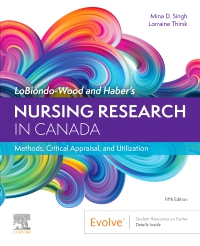
Nursing Research in Canada - Elsevier eBook on VitalSource, 5th Edition
Elsevier eBook on VitalSource

Now $52.19
Learn how to better understand and apply research to your everyday practice with LoBiondo-Wood and Haber’s Nursing Research in Canada: Methods, Critical Appraisal, and Utilization, 5th Edition. Written by an all-star team of educators and research experts from Canada and the US, this thoroughly updated text is the perfect resource to help ground you in the processes behind nursing research and evidence-informed practice. This edition features new research examples that reflect the most current Canadian studies, fresh vignettes, easy-to-use navigation tools, enhanced readability, and well-balanced coverage of both qualitative and quantitative research methods.
Newer Edition Available
LoBiondo-Wood & Haber's Nursing Research in Canada: Methods, Critical Appraisal, and Utilization - Elsevier E-Book on VitalSource
-
- Balanced-but-distinct coverage of both the qualitative and quantitative approaches to nursing research acquaints students with the processes behind research and evidence-informed practice.
- Complete, high-quality research examples, including four new sample critiques, demonstrate how to apply the judgement and reasoning principles outlined in the text to published quantitative and qualitative research studies.
- Research Vignettes introduce students to real-world practitioners of nursing research and help bridge the gaps among clinical research, academia, and clinical practice. Vignettes cover timely topics facing Canadian nurses such as immunization, Medical Assistance in Dying (MAiD), medical cannabis, public health, Indigenous health and nursing, and rural and remote nursing.
- Effective learning aids in every chapter include Key Terms, Learning Outcomes, Research Hints, Evidence-Informed Practice Tips, Appraising the Evidence, Critiquing Criteria, Critique of a Research Study, Critical Thinking Decision Paths, Critical Thinking Challenges, Critical Judgement Questions, and Key Points
-
- NEW! Part 2: Indigenous Peoples: Research, Knowledges, and Ways of Knowing introduces students to the history and significance of colonization as it relates to how Indigenous peoples have been affected by, and are affecting, nursing and health research.
- NEW! Inclusion of Indigenous Research Methods and application to the findings of the Truth and Reconciliation Committee.
- NEW! All-new research examples and vignettes demonstrate the most current, high-quality published studies to exemplify the work of prominent nurse-researchers and to encourage the development of clinical reasoning and judgement.
- NEW! Critical judgement-focused practice questions in the printed text, accompanying study guide, and companion Evolve website promote critical thinking and prepare students for exam licensure.
- NEW! Glossary of key terms at the end of the book gives students quick access to all new key terms.
-
Part 1: Research Overview
Research Vignette: Nursing research to improve immunization in Canada
Chapter 1 The Role of Research in Nursing
Chapter 2 Theoretical Frameworks
Chapter 3 Critical Appraisal Strategies: Reading Research
Chapter 4 Developing Research Questions, Hypotheses, and Clinical Questions
Chapter 5 Finding and Appraising the Literature
Chapter 6 Legal and Ethical Issues
Part 2: Indigenous Peoples: Research, Knowledges, and Ways of Knowing
Research Vignette: An Interview with Dr. Evelyn Voyageur
Chapter 7 Indigenous Peoples: Research, Knowledges, and Ways of Knowing
Part 3: Qualitative Research
Research Vignette: Public Health Nursing and the Social Construction of Mothering
Chapter 8 Introduction to Qualitative Research
Chapter 9 Qualitative Approaches to Research
Part 4: Quantitative Research
Research Vignette: Why I Focus on Violence Against Women and Girls (VAWG)
Chapter 10 Introduction to Quantitative Research
Chapter 11 Experimental and Quasiexperimental Designs
Chapter 12 Nonexperimental Designs
Part 5: Processes Related to Research
Research Vignette: Nursing Workforce
Chapter 13 Sampling
Chapter 14 Data-Collection Methods
Chapter 15 Rigour in Research
Chapter 16 Qualitative Data Analysis
Chapter 17 Quantitative Data Analysis
Chapter 18 Presenting the Findings
Part 6: Critiquing Research
Research Vignette: Rural and Remote Nursing Research
Chapter 19 Critiquing Qualitative Research
Chapter 20 Critiquing Quantitative Research
Part 7: Application of Research: Evidence-Informed Practice
Research Vignette: The influence of NP Program students in my current research portfolio: Exploring medical cannabis and applying it to clinical practice
Chapter 21 Developing an Evidence-Informed Practice
Research Vignette: Cancer Survivorship Program: Cancer, Work, Fear of Cancer Recurrence
APPENDICES
Appendix A. The rocks and hard places of MAiD: a qualitative study of nursing practice in the context of legislated assisted death
Appendix B. Lanolin for the treatment of nipple pain in breastfeeding women: a randomized controlled trial
Appendix C. Mâmawoh Kamâtowin, "Coming together to help each other in wellness": Honouring Indigenous Nursing Knowledge
Appendix D. How Does Simulation Impact Building Competency and Confidence in Recognition and Response to the Adult and Paediatric Deteriorating Patient Among Undergraduate Nursing Students?
Appendix E. Prenatal Maternal Anxiety as a Risk Factor for Preterm Birth and the Effects of Heterogeneity on this Relationship: A Systematic Review and Meta-Analysis
Glossary
Answers and Rationales to the Critical Judgement Questions





 as described in our
as described in our 